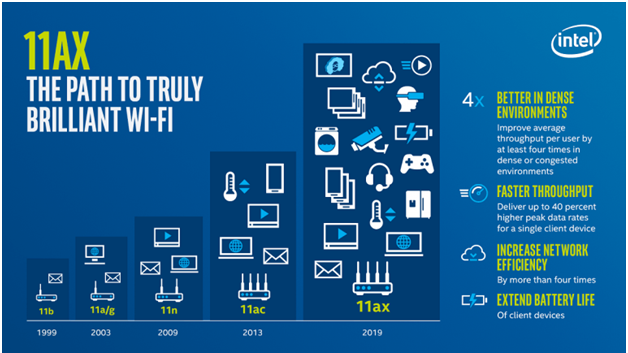
802.11ax, the next generation of Wi-Fi which knows no bound and hence delivers higher levels of efficiency in existing Wi-Fi networks. 802.11ax is a successor of 802.11ac WiFi standard, which will be official by late 2019 but we can see its pre-standard presence in both enterprises and consumer WLAN market. 802.11ax is designed to cater to a large number of devices at once without compromising on speed and avoiding interference.
As IEEE unveils the next generation of Wi-Fi standard-802.11ax, it’s time to delve into the details of the brand new transport to launch ourselves onto the World Wide Web.
So what exactly is 802.11ax?
The 802.11ax is a WLAN standard that comes under the 802.11xx bracket. Specifically designed for Wi-fi the 802.11ax is designed to provide 4 times the throughput of the currently existing standard. This is proving to be one of the challenging, yet highly rewarding enhancements. This standard is developed for places, which usually have high device densities- like railway platforms, stadiums, shopping malls, and more. The Internet of Things can also be benefited. It is also developed for cellular data offloading. Offloading in layman terms is taking a detour to cheaper and faster Wi-Fi networks from the cellular networks. Thus the new standard promises improved performance, faster speed, extended coverage, and longer battery life.
According to John Byrne, Technology Analyst at GlobalData, “The 802.11ax standard will drive a significant boost in capacity, efficiency and flexibility that should make Wi-Fi align closely with emerging 5G priorities. The ability to support up to 12 simultaneous user streams from a single access point, 8×8 multi-user multiple inputs multiple outputs, and the use of much larger 80 MHz channels of wireless spectrum represent dramatic upgrades from the current state-of-the-art standard, 802.11ac.”
Differences between 802.11ax and 802.11ac
The question arises how this “ax” extension is superior to its “ac” partner. What advantages does 802.11ax actually offer over the existing 802.11ac standard?
- The prime benefit 802.11ax offers is, up to four times the device capacity compared with 802.11ac. The device capacity can be understood in terms of speed, it allows as many gadgets at once but the uploading and downloading speed are smooth and faster than ever before.
Intel describes this as:
“802.11ax is expected to deliver up to 40 percent higher peak data rates for a single client device, improve average throughput per user by at least four times in congested environments and increase network efficiency by more than four times.”

| 802.11ax | 802.11ac |
| OFDMA is used as the multiplexing technique. | OFDMA is not present. |
| Multi-user MIMO available in uplink and downlink. | Multi-user MIMO used only in the downlink. |
| Trigger-based random access in an uplink. | It is not available. |
| Spatial frequency reuse is done. | No spatial frequency reuse. |
| Target Wake time available. | Target Wake time not available. |
| Dynamic fragmentation. | Static fragmentation. |
| Operates in 2.4Ghz and 5Ghz. | Operates in 5Ghz only. |
- 11ax offers good coverage in the world of connected devices and yet despite all of these improvements, it also gives you extended device battery life. The main goal of 802.11ax is to be better and more efficient 802.11 traffic management. Another goal is to increase the average throughput 4X per user in high-density WLAN environments.
- The important point is 802.11ax is backward compatible with older 802.11ax was designed for maximum compatibility, the 802.11ax specification has been introduced with changed Physical layer but it maintains backward compatibility with 802.11a/b/g/n and /ac devices.
- Its flexible wake-up time scheduling lets client devices sleep much longer than with 802.11ac, and wake up to less contention, extending the battery life of smartphones, IoT, and other devices.
Let us see the Key parameters of 802.11ax compared against 802.11ac.

Source: National Instruments 2017
The 802.11ax combines different technologies to provide the aforementioned. It achieves a fair increase in throughput by using higher order QAM modulation technique. It also uses beamforming technology to aim download streams to target users.
802.11ax Pre-Standard Presence
- The first company, to design a product for the latest standard was the Quantenna Communications, which supports both the 5 GHz and 2.4 GHz streams.
- Qualcomm, Broadcom, and Marvell have also announced their products.
- The first router was introduced by Asus, which achieves a throughput of 1.1Gbps and 2.4Gbps using a 4×4 MIMO respectively.
- Many other companies like Huawei, Aerohive networks have also announced their products.
The mass adoption of the latest standard may happen by 2020, but the promise it shows has awakened and freed the bottlenecks of wireless communication systems.



















